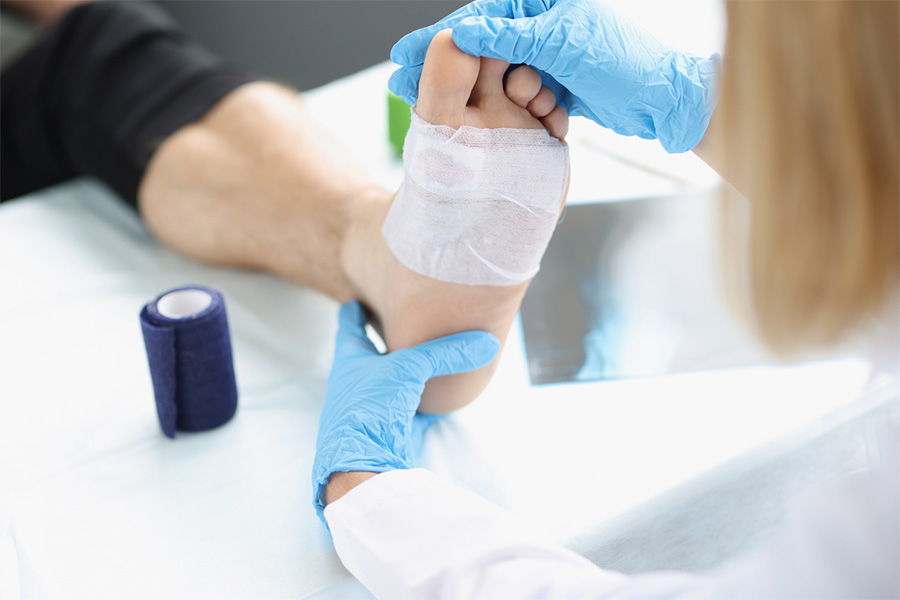Are you suffering from pain in your big toe’s joint? While there could be a few causes for this, a common reason is a chronic condition called hallux rigidus. Athletes and their trainers refer to it as “turf toe.”
Let’s learn what this condition is and how it is treated.
What Is Hallux Rigidus?
If you have recurring pain in your big toe, right where it meets the forefoot, you may have hallux rigidus, a progressive deterioration of the big toe joint. Affecting both men and women between the ages of 30 and 60, this soreness and stiffness is so common, one in every 40 podiatric patients has it. The experienced foot doctors at Cincinnati Foot & Ankle Care recognize its many symptoms. They offer treatments that relieve pain and increase mobility in the metatarsophalangeal joint at the base of the big toe.
What Are Its Symptoms?
Your symptoms may vary, but if you’re like most patients with hallux rigidus, you’ll feel soreness and pain when you walk or run, particularly as you push-off on the problem toe. You may develop a bony bump on the big toe joint, along with a callus on the top of your foot. As your condition progresses, your toe will stiffen more, even to the point where you cannot bend it at all.
What Causes Hallux Rigidus?
Osteoarthritis, also known as wear and tear arthritis, could be causing your big toe joint pain. Rheumatoid arthritis, inflammation, and swelling related to a defective immune system are causes, too.
Also, you may suffer hallux rigidus due to:
- Gout, the accumulation of uric acid in your joints
- Trauma to the toe (stubbing it or catching it on artificial turf, if you are a soccer or football player)
- Squatting repeatedly
- Running
- Inherited foot structure
- A bone spur visible on X-ray
Your condition may worsen if you do not seek treatment right away. Big toe joint pain does not go away on its own. You will benefit from a complete evaluation and care by the experts at Cincinnati Foot & Ankle Care in Milford, Ohio.
How Can Your Podiatrist Help?
Your foot doctor will review your symptoms and inspect your foot and big toe. They will take digital X-rays to visualize the problems with the bones (bone spurs, as an example). Also, the doctor will check your range of motion, determining how well you can flex the toe.
From there, you’ll receive a care plan to lessen your symptoms, helping you walk more easily and reducing swelling and soreness.
Treatment for your big toe joint pain may include:
- Pain medications, such as over the counter ibuprofen, as needed
- Stretching exercises to increase your range of motion
- Rest and ice, as needed
- Refraining from activities which aggravate the condition
- Wearing low-heeled shoes with supportive soles and roomy toe boxes
- Cortisone injections to reduce inflammation in the toe
- Customized shoe inserts (orthotics) to support the big toe joint and correct its motion
In some cases, patients benefit from surgery. Your podiatrist will tell you if you qualify for:
- Removal of bone spurs (chellectomy)
- Joint fusion (arthodesis)
- Joint repositioning and resurfacing (arthroplasty)
Treating Big Toe Joint Pain
Find relief for hallux rigidus by seeing an experienced and compassionate podiatrist. At Cincinnati Foot & Ankle Care, our highly-qualified team of 18 podiatrists treat a range of foot and ankle conditions. We feature the latest in technology and follow patients through detailed treatment plans tailored to their unique needs–whether acute or chronic health issues, injuries or the impact of aging or athletic training.
Call our office most convenient to you for a consultation today, or use the online appointment request form. We have 18 locations in the greater Cincinnati area–all ready to serve you.





